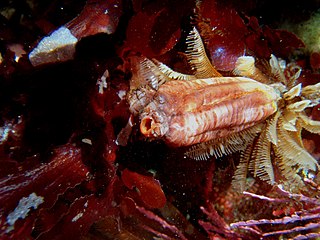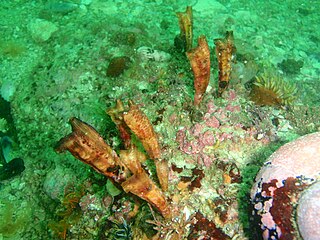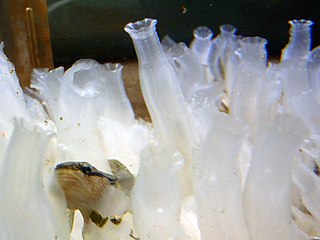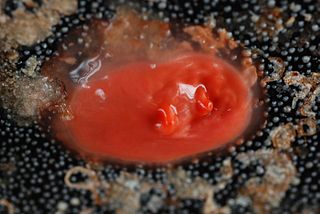
A tunicate is a marine invertebrate animal, a member of the subphylum Tunicata. It is part of the Chordata, a phylum which includes all animals with dorsal nerve cords and notochords. The subphylum was at one time called Urochordata, and the term urochordates is still sometimes used for these animals. They are the only chordates that have lost their myomeric segmentation, with the possible exception of the 'seriation of the gill slits'. However, doliolids still display segmentation of the muscle bands.

Ascidiacea, commonly known as the ascidians or sea squirts, is a paraphyletic class in the subphylum Tunicata of sac-like marine invertebrate filter feeders. Ascidians are characterized by a tough outer "tunic" made of a polysaccharide.

Ciona intestinalis is an ascidian, a tunicate with very soft tunic. Its Latin name literally means "pillar of intestines", referring to the fact that its body is a soft, translucent column-like structure, resembling a mass of intestines sprouting from a rock. It is a globally distributed cosmopolitan species. Since Linnaeus described the species, Ciona intestinalis has been used as a model invertebrate chordate in developmental biology and genomics. Studies conducted between 2005 and 2010 have shown that there are at least two, possibly four, sister species. More recently it has been shown that one of these species has already been described as Ciona robusta. By anthropogenic means, the species has invaded various parts of the world and is known as an invasive species.

Pleurogona is an order of tunicates which is no longer in use as it contains the same families as Stolidobranchia.

Styela is a genus of tunicates. Styela clava, an edible species, is known as an invasive species in some areas.

Canadian aquatic invasive species are all forms of life that traditionally has not been native to Canada's waterways. In Eastern Canada, non-native plant and animal species are a concern to biologists. Bringing non-native species such as invasive fishes into Canada can damage the environment and ecosystem by repressing native species due to food competition or preying. Invasive fishes enter the fresh waters of Canada in several ways including drifting, deliberate introduction, accidental release, experimental purposes and, most commonly, through the attachment on international boat hulls. Invasive species are the second biggest threat to fish and other marine life in Canada behind loss of habitat and degradation. The threat to native species is primarily caused by impacts on the food web; however, invasive species also bring dangerous pathogens and physically interfere with existing aquatic life. Invasive species include sea lampreys, zebra mussels, smallmouth bass, European green crab, vase tunicate, and sea squirts.

Styela plicata, commonly known as pleated sea squirt, is a species of tunicate in the family Styelidae. This sessile filter feeder can expel water when threatened.

Styela montereyensis, also called the stalked tunicate, Monterey stalked tunicate, and the long-stalked sea squirt is a solitary ascidian tunicate. It has a cylindrical, yellow to dark reddish-brown body and a thin trunk that anchors it to rocks. It is found in subtidal areas of the western coast of North America from Vancouver Island to Baja California.

Ecteinascidia turbinata, commonly known as the mangrove tunicate, is a species of sea squirt species in the family Perophoridae. It was described to science in 1880 by William Abbott Herdman. The cancer drug trabectedin is isolated from E. turbinata.

Didemnum molle is a species of colonial tunicate in the family Didemnidae. It is commonly known as the tall urn ascidian, the green barrel sea squirt or the green reef sea-squirt. It is native to the Red Sea and the tropical waters of the Indo-Pacific region.

Didemnum vexillum is a species of colonial tunicate in the family Didemnidae. It is commonly called sea vomit, marine vomit, pancake batter tunicate, or carpet sea squirt. It is thought to be native to Japan, but it has been reported as an invasive species in a number of places in Europe, North America and New Zealand. It is sometimes given the nickname "D. vex" because of the vexing way in which it dominates marine ecosystems when introduced into new locations, however the species epithet vexillum actually derives from the Latin word for flag, and the species was so named because of the way colonies' long tendrils appear to wave in the water like a flag.

Ciona savignyi is a marine animal sometimes known as the Pacific transparent sea squirt or solitary sea squirt. It is a species of tunicates in the family Cionidae. It is found in shallow waters around Japan and has spread to the west coast of North America where it is regarded as an invasive species.

Pyura pachydermatina is a sea tulip, a solitary species of tunicate in the suborder Stolidobranchia. It is native to shallow waters around New Zealand.

Styela angularis is a solitary, hermaphroditic ascidian tunicate that is found along the coast of Southern Africa from Lüderitz Bay in Namibia to the Eastern Cape.
Polyandrocarpa is a genus of ascidian tunicates within the family Styelidae.

Molgula manhattensis, commonly known as "sea grapes", is a species of ascidian commonly found along the East Coast and Gulf Coast region of the United States. Although it is native to this region, it has been introduced to other areas of Europe, Australia, and the West Coast.

Ciona robusta is a species of marine invertebrate in the genus Ciona of the family Cionidae. The holotype was collected on the northeastern coast of Honshu Island, Japan. Populations of Ciona intestinalis known as Ciona intestinalis type A found in the Mediterranean Sea, the Pacific Ocean, east coast of North America, and the Atlantic coasts of South Africa have been shown to be Ciona robusta.

Cnemidocarpa finmarkiensis is a species of solitary ascidian tunicate in the family Styelidae. Common names include broad base sea squirt, orange sea squirt, red sea squirt, shiny orange sea squirt, shiny red tunicate and Finmark's tunicate. It is native to shallow waters in the northern and northeastern Pacific Ocean.

Pyura haustor is a species of sessile ascidian, or sea squirt, that lives in coastal waters in the north-eastern Pacific Ocean, attached to rocks or artificial structures. Common names for this species include the wrinkled seapump, the wrinkled sea squirt and the warty tunicate.
















